|
George Eastman Hall
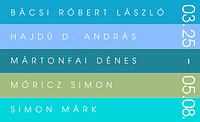
upcoming
exhibition
Róbert László Bácsi, András D. Hajdú, Dénes Mártonfai, Simon Móricz, Márk Simon
József Pécsi Fine Art Photography Grant
Opening remarks by Péter Korniss, photographer
Curator: Szilvia Nagy, curator of the Miskolc Gallery of Contemporary Art
Open to the public:
25th March to 8th May 2011
Every weekdays: 14.00 - 19.00
Weekend: 11.00 - 19.00
The József Pécsi Grant has provided an opportunity for young
photographers over the last 20 years to focus on their projects in one-year
periods of up to 3 years. The annual exhibition and catalogue of 2011 presents
the photographic series of Róbert László Bácsi, András Hajdú D., Dénes
Mártonfai, Simon Móricz and Márk Simon. The mature and thematically consistent
series give a sample of the socially critical inquiries of young artists; the
images combine social-political sensitivity with a documentary mode of
expression and artistic reflection.
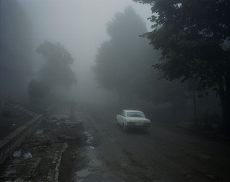

The photographs of Róbert László Bácsi formulate the "unacknowledged"
path-seekings and conflicts of an "unacknowledged" country into lyrical
stillness. Symbols of the past are slowly flaking off the walls; portraits of
locals alternate with the reliefs of leaders; the tank and the carousel are both
reduced to landmarks in this panorama of silent decay. Landscapes burdened with
historical memory; people posing with guns in their homes evoke the unknown
world of The Armenian Karabakh.
The Armenian Karabakh
If one travels to an unacknowledged country, it is worth to be prepared for the lack of internet roaming. Despite this small inconvenience, an unacknowledged country is much the same as an acknowledged one, except it is not invited to the Olympics, half of the male population is in arms, commerce is a little cumbersome, and there are no tourists. Instead, there are borders with unacknowledged border guards, offices with unacknowledged stamps, governments with unacknowledged ministers.
The Caucasian territory, populated mostly by Armenians, declared its independence from Azerbaijan after the fall of the Soviet Union, although the world has never acknowledged this. The initial years were characterized by economic crisis, and an open war broke out between Azerbaijan and the Armenian population of the Mountain Karabakh. Azerbaijan claims that Armenia - illegitimately - occupied the territory with a population of 140 000. So far, the war, which broke out because of the secession, demanded 35 000 casualties.
The two neighbouring countries are officially at war to date, as Armenia still has claims to the Mountain Karabakh province of Azerbaijan, inhabited mostly by Armenians.
The impact of the Armenian Holocaust and the war with Azerbaijan on their everyday life is still perceivable. People everywhere are surrounded by the memories of their deceased family members. Reflections of old photographs on the walls; of sadness on the faces. Firearms are still a natural part of many households. Often the grandparents raise the children, as their parents have perished in the war.
With my work I intend to give insight into the atmosphere of this "country" where development is slow, where the families find it hard to move on under the burden of the past.

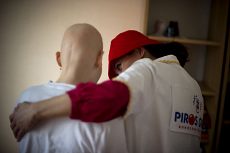
The presence of the Clown Doctors is merely hinted at by volatile soap bubbles
in some of the photographs. The photo series of András D. Hajdú guides us
through hospital wards, among the elderly and the youngest. These rows of images
document fragile moments, juxtaposing moments of happiness and hopelessness,
weakness and will, dependence and desire to help. An expert eye helps us grasp
these delicate situations and critical moments for a split second, after which
they evaporate like bubbles.
Clown Doctors
My goal with this series is to give insight into the lesser known job of clown doctors. I consider it very important to document those sincere moments that are created by such infinitely fragile situations as dependence and the desire to help. During several months of ceaseless hard work, the doctors try getting closer to the elderly and the children, until they reach the point where the accumulated fear, tension and melancholy can burst out in a single sincere bout of laughter. This is the moment these clowns have worked years for.
In 2009 I focused on home for the elderly, on how they were trying to jolt old people out of their apathy. Women in these homes are generally expecting the clowns with great enthusiasm, but the men are almost impossible to loosen up - they are much prouder than to "fraternize" with these clowns of sorts. However, their consistent return sometimes breaks even the strongest resistance, and occasionally even the most stubborn person can be made to forget their gloominess.
In children's homes and institutes the development of relationships requires a lot more effort on both sides, as the children are perfectly aware of their condition as well as the fact that the clowns visit to get their minds off their ailment. If a clown's attention wanders for a moment, a sick child often "gives a hand" to the clowns, assisting them in doing their job. These clowns need to exhibit almost superhuman strength and empathy.
Special thanks for Red Noses Clowndoctors Foundation.
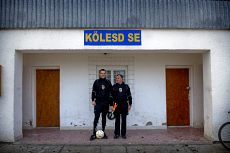

The two series of Dénes Mártonfai document sportsmen and fans who wish
to break free of the quotidian cycle of provincial existence (Provincial
Football) and portray Everyday Girls who desire to show themselves in their
quest for identity. Viewing the former series, we get a feeling that everything
is possible in the countryside: the makeshift benches and goals transmute into a
stadium, the corner pub into a bar celebrating football stars when a match with
the neighbouring village team turns into the event of the month.
The Everyday Girls series represents its models balancing on the thin
line between irony, pornography and kitsch, for a moment tearing them out of
their daily routines, which are so hard to abandon; letting them give in to
their desire to show themselves, while leaving them invisible to their own
community, leaving intact their status as everyday girls.
Dénes Mártonfai
Provincal Football
Many people have no idea what it is like to cheer our relative or childhood friend from a makeshift wood bench, from behind a low fence that we could step across even with a crutch. It is a completely different feeling than surrounded by iron railings and concrete walls, encaged in a sector of a stadium. Today more than ever, we can experience how the love of sport is manifested differently in the countryside. The atmosphere of matches is fundamentally different. We can experience what it is like to discuss the mistakes with the team members after the match, drinking beer at the courtside kiosk. On the occasion, which counts as a social event among the men, the fans discuss the events of the week and peacefully watch the match. And although the fanaticism of fans is not absent on these occasions either, it is undeniably of a different nature than in a huge closed arena: there is no a trace of serious aggression. And there is no greater happiness for the faithful fan than if their team is victorious.
Everyday Girls
My job as photojournalist includes working for the online edition of Tolnai Népújság. One of its weekly columns is the TEOL-girl, which presents the portfolios of young volunteer girls. There being no other opportunity, a lot of girls apply. Girlfriends pass the news amongst themselves that they can become photo models, and so they can enter the public consciousness for a short time. This opportunity alone is a way to temporarily exit the daily grind. My models are none other than everyday girls who consider themselves dull, and who, stripping their inhibitions, show what true beauty is, and not the ideal transmitted in the media. For a photo to be good, it is necessary to get acquainted with the girls. The unconventional images are the result of these conversations. Some were only driven by curiosity in their desire to pose for the photographs in dresses and against backgrounds that had nothing to do with their everydays. As it has turned out, however, the so-called simple, everyday girls are also full of special dreams and occasionally repressed desires, which is then combined with my particular vision. The goal is for them to show their deepest selves at least once in this life. I would like to continue giving space and new sites to these dreams and fantasies.
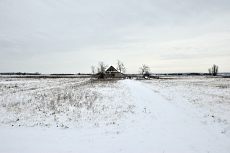

The photographs of Simon Móricz comprise a documentary photo essay,
showing a story of struggle with empathy and social criticism. Csanytelek of
Csongrád County, known as the Mudland, is one of the many settlements
along the river Tisza, which struggle with the lack of infrastructure. The
unresolved issue of the inadequate network of public roads raises educational
and healthcare problems. These images show the everyday life of the locals:
tractors stuck in the mud, impossible transportation, hopelessness, the need for
communion, and above all, mud.
Mudland
While in Western Europe 96% of public roads are paved, in Hungary this ratio is only 38%. The difference is even greater in rural areas. While in Western Europe almost all agricultural roads are paved, in Hungary only a third of them are covered in asphalt. Rural agricultural roads are in the property of local governments, which primarily allot their scanty resources to urban areas, and the Ministry of Economy and Transport does not deal with rural dirt roads, either. The improvement of the existing roads and the construction of new ones would require a cooperation of the development sector and the local governments.
In the settlement of Csanytelek, Csongrád County, 30% of the population lives along dirt roads. Near the River Tisza, the ground is rendered completely impassable in rainy weather. In 2007 they spent 2 million Forints on the design, permits and application required for preparing the renovation of three dirt streets in particularly bad condition. The local government did not win the grant, because they failed to provide traffic count data and accident statistics to prove the need for a pavement. It is impossible to provide high traffic data to justify the necessity of renovating a road that is impassable during most of the year; nor do hay carts ever collide on a street where even jeeps get stuck. Here, like in a number of similar settlements, not only is the ambulance unable to reach an angina patient in 15 minutes, but it is difficult even to find a tractor that would tow that ambulance to the patient's house on such short notice. The complete road network of Csanytelek is 70 km in length, 40 km of which lies in residential areas.

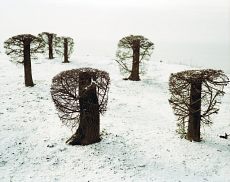
Márk Simon's medium format photographs reinterpret a place familiar to
all of us: Lake Balaton. His series Lacus Pelso / Shallow Lake recalls an
atmosphere other than that of holidays at Balaton: he shows a heretofore
familiar landscape from an entirely new perspective, constructing his series
along associations and personal memories, returning time and again, musing,
arranged into timelessness. The governing tones of the images document a
capricious mood, ordering the passing of time along a colour scale.
Lacus Pelso - Shallow Lake
The lake from where you can go on, where you can rest, let the steam off, immerse. It attracts the traveller, but it also lets them take a break and poses a challenge. It has a history: for the ancient Romans, the Pelso rows of villas; for medieval Hungarians the system of marsh castles and strongholds; for the modern East-Germans the Plattensee of freedom; and for us, the Hungarian Sea, where langosh tastes good and union holidays are inevitable.
Lake Balaton is all this and more: distance, remoteness, the infinite wandering of the gaze. It is at once finite and infinite, momentary and eternal. It is there in the stones of the houses, in the movements of bathers, it shapes our words, our customs, our songs. Is it a primordial element, a loch, och aye an eye, a mirror of the sky, the mirror of the soul, or the sea inside? These are the questions to which I am seeking the answer.
Szilvia Nagy, curator
|
Hungarian House of Photography in Mai Manó House
H-1065 Budapest-Terézváros, Nagymező utca 20.
Telephone: 473-2666
Fax: 473-2662
E-mail: maimano@maimano.hu
|
|
|


